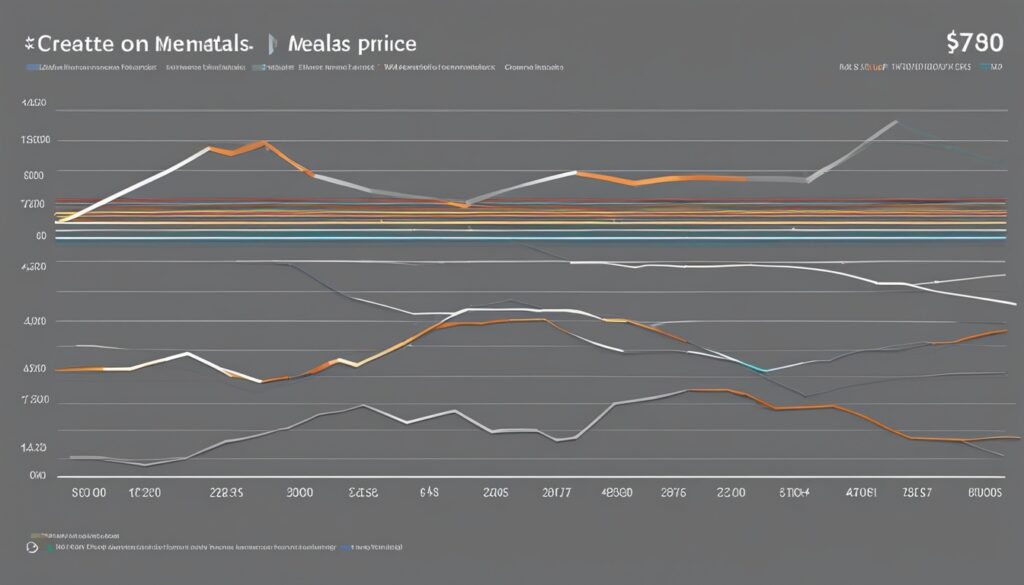Are you aware that investing in precious metals can offer stability and diversification to your investment portfolio? Whether you are an experienced investor or just beginning, knowing the important questions to ask before investing in precious metals is essential.
With fluctuating markets and economic uncertainties, investing in precious metals like gold, silver, and platinum has become increasingly popular in recent years. These valuable commodities offer tangibility, liquidity, and a hedge against inflation that can protect your wealth.
In this article, we will explore the top 10 queries you should consider before making your investment, guiding you through important decisions such as the best form of ownership, storage options, ongoing costs, and liquidity of your precious metals investment.
Key Takeaways:
- Investing in precious metals can provide stability and diversification to your portfolio.
- Understanding the key questions to ask before investing is crucial.
- Consider the best form of ownership, storage options, ongoing costs, and liquidity.
Physical, Digital, or Paper?
When considering investing in precious metals, one of the first decisions you’ll need to make is how you prefer to hold them. There are three main options to choose from: physical precious metals, digital gold, and paper gold.
Physical Precious Metals

The traditional route of investing in precious metals involves acquiring physical coins and bars. This form of investment provides direct ownership title and offers a tangible asset. Physical precious metals can be securely stored at home, in a safe deposit box, or by availing the services of reputable storage providers.
Digital Gold
For those seeking a more convenient and accessible option, digital gold provides a viable alternative. Digital gold allows investors to own a fraction of a gold bar or coin without the need for physical possession. Companies like Goldmoney and Uphold offer digital gold platforms that ensure transparency and the ability to buy, sell, and hold digital gold securely.
Paper Gold
Paper gold options include gold certificates and futures contracts.
Gold certificates provide a way to invest in gold without physically owning it. These certificates represent a claim against a specific amount of gold held by a financial institution. However, it’s important to note that paper gold options do not grant ownership title to the underlying metal.
Similarly, futures contracts offer exposure to the price of gold but do not provide direct ownership. Futures contracts are agreements to buy or sell gold at a specific price and date in the future. While they offer flexibility for traders, they may not be suitable for long-term investors.
It’s important to weigh the advantages and disadvantages of each investment option based on your personal preferences, goals, and risk tolerance. Physical precious metals provide direct ownership and no counterparty risk, while digital gold and paper gold options offer accessibility and flexibility. Consider your investment objectives, storage capabilities, and desired level of ownership when making a decision.
Allocated or Unallocated Metals?
The type of precious metals you invest in can have significant implications on your investment’s safety. When deciding between allocated precious metals and unallocated precious metals, it’s important to consider the level of investor safety and the potential counterparty risk involved.
Allocated precious metals provide the highest degree of investor safety. When you invest in allocated precious metals, your holdings are physically segregated and unencumbered. This means that your investment is held separately from the assets of the bullion bank or storage provider, reducing the risk of loss or default. You have ownership title to the specific metal bars or coins, ensuring that they are fully allocated to you.
On the other hand, unallocated precious metals introduce counterparty risk. When you invest in unallocated metals, your investment is not specifically assigned to you. Instead, it is pooled with the investments of other investors. While this may offer some cost and administrative advantages, it also means that ownership title is not secured by the investor. In the event of issuer insolvency or bankruptcy, there is a risk that investor claims may exceed the total amount of underlying metal, leading to potential losses.
It’s important to understand the potential risks and benefits of allocated and unallocated precious metals before making your investment decision. By considering the safety of your investment and the level of counterparty risk you are comfortable with, you can make a more informed choice that aligns with your investment goals and risk tolerance.
Allocated Precious Metals vs. Unallocated Precious Metals
To better illustrate the differences between allocated and unallocated precious metals, consider the following comparison:
| Allocated Precious Metals | Unallocated Precious Metals |
|---|---|
| Your investment is physically segregated | Your investment is pooled with other investors |
| You have ownership title to specific metal bars or coins | Ownership title is not secured by the investor |
| Reduces the risk of loss or default | Potential for investor claims to exceed the total amount of underlying metal |
| Offers the highest degree of investor safety | Introduces counterparty risk |

Is There a Mark-Up to Spot Metals Prices?
Investors considering precious metals have often wondered about the mark-up over spot prices when purchasing coins and bars. It’s important to understand this aspect as it impacts the overall cost and potential returns on investment. Additionally, different investment vehicles such as exchange-traded funds (ETFs) and closed-end funds have their own pricing structures. Let’s take a closer look at the mark-up to spot metals prices and how it varies across investment options.
Coins and Bars
When purchasing physical precious metals in the form of coins and bars, there is typically a mark-up ranging from 2% to 8% over the spot price. The mark-up covers various factors such as refining costs, minting fees, and the profit margin for dealers. It’s important to consider this mark-up when calculating the total cost of acquiring physical precious metals. These tangible assets offer direct ownership and the ability to personally hold and store them, providing a sense of security and control.
Exchange-Traded Funds (ETFs)
In contrast, exchange-traded funds (ETFs) work differently when it comes to pricing. ETFs that track the spot price of precious metals typically aim to closely align with the spot price, eliminating the mark-up associated with coins and bars. However, ETFs may have management fees, which can impact the overall cost of investment. These fees cover expenses such as custodial and administrative services. Investors should consider the management fees and evaluate the trade-off between convenience and potential cost savings.
Closed-End Funds
Closed-end funds, on the other hand, may trade at a discount or premium to the underlying spot price. The discount or premium reflects market demand, investor sentiment, and fund-specific factors. While closed-end funds offer the potential for trading at a discount to spot prices, investors need to consider additional costs such as management fees and potential mark-downs when selling their shares. These factors can influence the overall return on investment and should be carefully evaluated.
| Investment Vehicle | Mark-Up to Spot Prices | Additional Considerations |
|---|---|---|
| Coins and Bars | Ranging from 2% to 8% | Tangible ownership, storage, and insurance costs |
| Exchange-Traded Funds (ETFs) | Minimal mark-up; closely aligned with spot price | Management fees, convenience of ownership |
| Closed-End Funds | Discount or premium to spot price | Management fees, potential mark-downs |
When exploring different investment options, it’s essential to consider the mark-up to spot metals prices, along with associated costs and potential additional fees. A well-informed investor carefully evaluates the trade-offs between ownership, convenience, and potential returns. By understanding these pricing dynamics, investors can make informed decisions that align with their investment goals and risk tolerance.

Where are My Precious Metals Stored?
When it comes to investing in precious metals, one important consideration is the storage of your assets. To ensure the safety and security of your investment, it’s crucial to choose reputable storage providers that offer insured storage facilities.
For investors who opt for precious metals ETFs, it’s essential to understand where the underlying metals are stored. Many precious metals ETFs store the metals at renowned bullion banks such as HSBC or JP Morgan. While these banks are well-established and trusted, it’s important to note that some ETFs may use sub-custodians for storage, which can introduce additional counterparty risk.
Minimizing counterparty risk is paramount, and selecting trustworthy and reputable storage facilities is crucial. Insured storage provided by reputable storage providers can mitigate the risk of loss or damage to your precious metals, giving you peace of mind.

Benefits of Choosing Reputable Storage Providers
1. Enhanced Security: Reputable storage providers prioritize the security of your precious metals with state-of-the-art measures like advanced surveillance systems, secure vaults, and robust access controls.
2. Insurance Coverage: Insured storage facilities offer protection against theft, loss, or damage, ensuring that you are financially safeguarded in case of unforeseen events.
3. Professional Maintenance: Reputable storage providers have the expertise to properly handle, store, and maintain your precious metals, ensuring their long-term preservation.
4. Auditability: Regular audits conducted by reputable storage providers offer transparency and reassurance to investors, verifying the existence and integrity of their metal holdings.
By choosing storage providers that prioritize security, insurance coverage, professional maintenance, and auditability, investors can minimize the risk associated with storing their precious metals. Remember, ensuring the safety of your investment is key to maximizing the potential benefits of investing in precious metals.
Can I Take Delivery of My Precious Metals?
When investing in precious metals, one important consideration is whether or not you can take physical delivery of your investment. This decision will depend on the type of investment vehicle you choose, each with its own implications.
If you opt for a direct investment in coins and bars, you have the advantage of easy physical delivery. This means that you can physically possess the precious metals you own. However, it’s important to note that direct ownership of physical metals may come with trade-offs, such as mark-ups over spot prices and the requirement for secure storage.

Did you know? Taking physical delivery of coins and bars allows you to have direct control over your precious metals. It can be satisfying to have tangible assets in your possession.
On the other hand, precious metals ETFs generally do not permit average investors to take physical delivery. ETFs offer a convenient way to invest in precious metals without the need for storing and securing physical coins and bars. Instead, investors own shares of the ETF, which represents their proportionate ownership of the underlying metal.
While most ETF investors won’t have the option to take physical delivery, some closed-end funds may offer this feature. Closed-end funds function similarly to ETFs, but their shares trade at discounts or premiums to the fund’s net asset value. These funds may cater to investors who want the option to convert their investment into physical metals if desired.
Benefits of Physical Delivery
Having the ability to take physical delivery of your precious metals can provide a sense of security and control over your investment. It allows for direct ownership and the flexibility to store or sell the metals as you see fit. However, it’s essential to consider the associated costs and responsibilities when choosing a bullion investment vehicle.
What are the Ongoing Costs?
Owning physical precious metals comes with various ongoing costs that investors should consider. These costs include insurance and storage expenses to protect and securely store your precious metals. Additionally, when investing in precious metals through exchange-traded funds (ETFs) or closed-end funds, there are management fees associated with these investment vehicles.
Insurance is an essential aspect of physical ownership, ensuring that your investment is protected against potential risks such as theft or damage. The cost of insurance may vary based on factors such as the value of your precious metals and the level of coverage you require.
Storage expenses are another ongoing cost to consider. Depending on your preference and the quantity of precious metals you own, you can choose to store them at home or utilize a professional storage facility. Professional storage facilities offer secure and insured storage options, providing peace of mind regarding the safety of your investment.
When investing in precious metals through ETFs or closed-end funds, management fees apply to cover the costs associated with managing the investment vehicle. These fees may vary and are typically charged on an annual basis.
It is essential to carefully evaluate and compare the costs associated with different investment options to determine the overall value you will receive. Consider factors such as insurance costs, storage expenses, and management fees when making an informed investment decision.
Comparing the Ongoing Costs:
| Investment Option | Physical Ownership Costs | Insurance | Storage | Management Fees |
|---|---|---|---|---|
| Physical Precious Metals | Incurred | Incurred | Incurred | N/A |
| ETFs | Incurred | Incurred | Not applicable | Annual fee |
| Closed-End Funds | Incurred | Incurred | Not applicable | Annual fee |
Note: The ongoing physical ownership costs include insurance and storage expenses that may vary based on individual circumstances.

How Liquid is My Investment?
Liquidity is a crucial consideration when investing in precious metals. Understanding the ease and convenience of selling your investment can greatly impact your overall investment strategy. Let’s explore the different liquidity options available for precious metals.
Coins and Bars: Selling Process
When it comes to selling coins and bars, the process can be more complex and time-consuming compared to other investment options. You may need to find a reputable buyer, assess the market value, negotiate a price, and physically deliver the precious metals. This can pose challenges, especially if you’re unfamiliar with the selling process or in urgent need of liquidity.
ETFs: Quick and Convenient Trades
On the other hand, Exchange-Traded Funds (ETFs) offer a more convenient way to sell your investment. ETFs trade on exchanges throughout the trading day, allowing you to buy or sell shares with ease. This provides quick access to liquidity, especially if you need to capitalize on market opportunities or adjust your investment portfolio swiftly.
Closed-End Funds: Efficient Selling Mechanism
Closed-End Funds also provide a convenient selling mechanism for precious metals. These investment funds have a fixed number of shares that trade on exchanges, allowing you to sell your investment like you would with ETFs. However, it’s important to consider that closed-end funds may trade at significant discounts or premiums to the underlying asset value, which can impact your potential returns.
When it comes to liquidity, ETFs and closed-end funds offer more efficient selling mechanisms compared to the process of selling coins and bars. These investment vehicles provide the convenience of buying and selling on exchanges, making it easier to access the liquidity you need.
It’s essential to note that regardless of the investment option you choose, there may still be settlement periods to consider. For example, ETF and closed-end fund sales generally require a settlement period of three business days after the sell order is executed. This is a common practice in the financial industry to facilitate the smooth settlement of transactions.
By carefully evaluating your investment needs, liquidity preferences, and tolerance for the selling process, you can determine which option aligns best with your investment goals.

| Investment Option | Liquidity | Selling Process |
|---|---|---|
| Coins and Bars | Less liquid | Complex and time-consuming |
| ETFs | Highly liquid | Quick and convenient trades on exchanges |
| Closed-End Funds | Relatively liquid | Efficient selling mechanism on exchanges |
Conclusion
Investing in precious metals can be a valuable part of a well-diversified portfolio. With their stability, tangibility, and liquidity, precious metals offer attractive opportunities for both short-term and long-term goals. By carefully considering essential queries before investing, investors can navigate the world of precious metals with confidence and make informed investment decisions based on their individual goals and risk tolerance.
Adding precious metals to a diversified portfolio can provide a hedge against market volatility and inflation while diversifying risk across different asset classes. Whether it’s gold, silver, platinum, or palladium, these precious metals have long been recognized for their intrinsic value and ability to preserve wealth.
Investors should evaluate their investment objectives, time horizon, and risk appetite to determine their allocation to precious metals. They should also consider factors like storage costs, ongoing insurance expenses, and potential mark-ups when selecting the right investment vehicle. By incorporating precious metals into a well-diversified portfolio, investors can enhance its overall stability and potentially increase their long-term returns.










